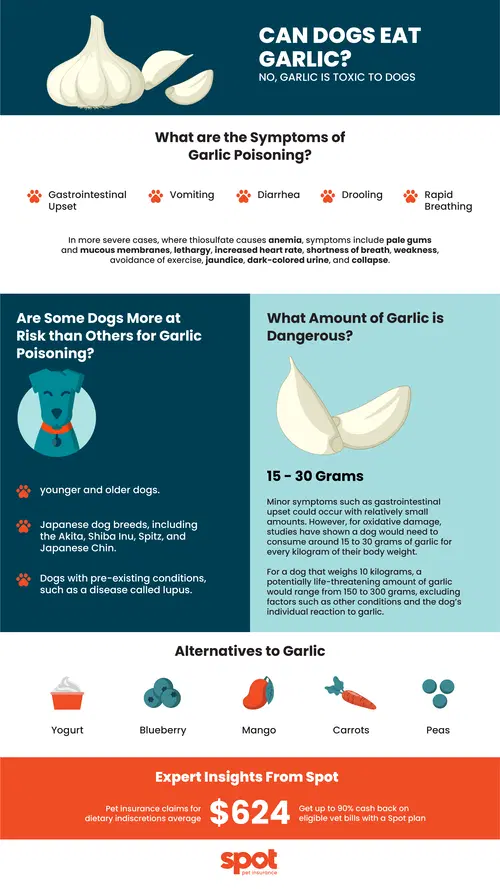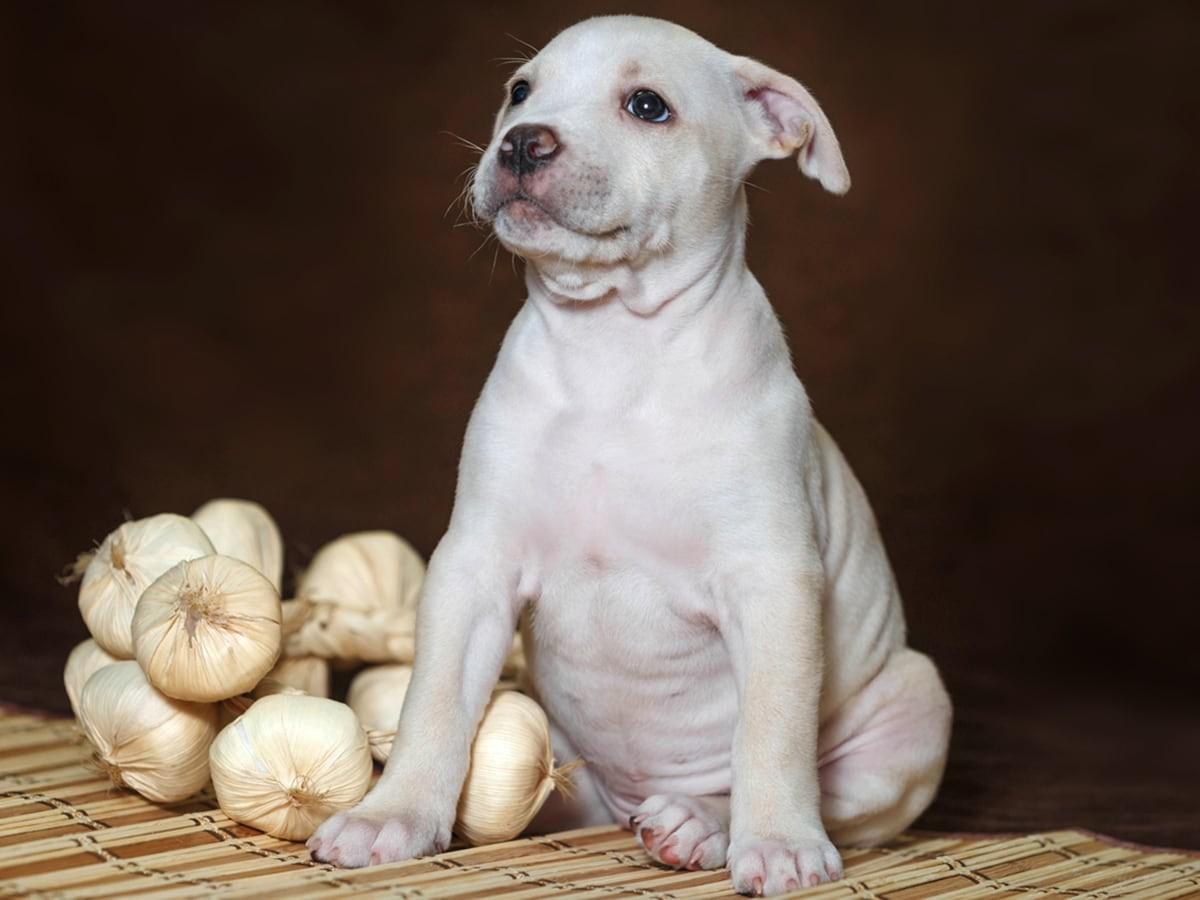Garlic is a staple in many cuisines and cultures. It’s one of our favorite ways to season foods, and it’s no surprise why. Garlic tastes delicious, and the aroma of garlic may be even better. There are also numerous health benefits for humans when eating garlic.
So it may surprise you to learn that garlic is toxic to many animals, including dogs, cats, horses, birds, reptiles, sheep, goats, and cattle.1 What makes this vegetable and its close relatives so toxic, and why can’t our canine friends digest it?
Today, Spot Pet Insurance is here to help. We’re diving into all the details around garlic so you can confidently approach your pet parenting responsibilities to help keep your dog healthy and safe.

Is Garlic Safe for Dogs?
Garlic is not safe to dogs to eat. However tempting those puppy eyes may be, it’s essential that you know exactly what’s on your plate and whether it’s appropriate for your dog to eat before letting them have a bite.
Some dogs may not be affected by eating a small amount of garlic, but ingestion of large amounts can be very toxic – even deadly.1 Since each dog reacts differently and the potential consequences are so severe, the safest approach is not to give any dog garlic in any form.
If your dog does consume garlic, you should contact a professional pet poison service or your vet. Prompt diagnosis and treatment have the power to save pets lives. While there’s no question that garlic is an unsafe food for dogs, you’re probably wondering why this is the case. Let’s look a little deeper at the details.
Why Is Garlic Dangerous?
Several plants in the Allium genus are toxic to dogs, but none more so than garlic. The Pet Poison Helpline rates garlic as a moderately toxic substance for dogs (it’s even more dangerous for cats), so it’s not quite as dangerous as antifreeze or laundry detergent.1
It is, however, exceptionally dangerous for dogs amongst human foods, even though the benefits of garlic are numerous for humans. In fact, garlic is five times more toxic than other alliums such as onions.1
The key toxic agent in garlic is called thiosulfate. This chemical is safe enough for humans, but most animals cannot safely consume it. Garlic toxicity can cause gastrointestinal upset, but the true danger of thiosulfate from garlic is that it can cause oxidative damage (hemolysis) to red blood cells.
Like for most creatures, your dog’s red blood cells carry oxygen around the body, especially to vital organs. As these cells are destroyed, the vital organs aren’t able to receive sufficient oxygen, which can lead to hemolytic anemia.3
A low red blood cell count is known as anemia. Anemia is often synonymous with lethargy since, without enough oxygen, your dog’s energy levels will inevitably drop significantly. There are, however, many symptoms to look out for, which we will expand upon a little later.
Anemia is the most dangerous result of garlic poisoning. If left untreated, it could lead to kidney damage (which is often irreversible), collapse, or even death.4
What Are The Symptoms Of Garlic Poisoning?
Knowing the symptoms of garlic poisoning could be life-saving for your dog. Gastrointestinal upset symptoms are the most common and likely will be the first to manifest if your dog has eaten garlic and reacts adversely. Other symptoms of garlic poisoning include:
diarrhea
nausea
drooling
rapid breathing
dehydration
These symptoms are uncomfortable at best and could risk further problems for some dogs.4 In more severe cases, where thiosulfate causes anemia, symptoms include:
pale gums and mucous membranes,
lethargy
increased heart rate
shortness of breath
weakness
avoidance of exercise
jaundice
dark-colored urine
collapse
How quickly symptoms appear tends to scale with the amount of garlic eaten. With large amounts, symptoms could appear within the first 24 hours. Symptoms caused by smaller amounts of garlic might take longer, up to a week, to show.1
What Amount Of Garlic Is Dangerous?
The amount of garlic needed to cause garlic poisoning varies. According to the American Kennel Club, minor symptoms such as gastrointestinal upset could occur with relatively small amounts. However, for oxidative damage, studies have shown that a dog would need to consume around 15 to 30 grams of garlic for every kilogram of their body weight.
For a dog that weighs 10 kilograms, a potentially life-threatening amount of garlic could range from 150 to 300 grams, excluding factors such as other conditions and the dog’s individual reaction to garlic.
To put this in perspective, a clove of garlic is generally 4-8 grams. A head of garlic often contains around 10-15 cloves, which means they tend to weigh 40-60 grams. It could take a large amount of garlic to lead to anemia for some dogs, but some factors could make a dog more at risk.
Garlic poisoning can also build up through regular feeding of garlic, even in small amounts. You should never intentionally feed your dog garlic, but if they do accidentally consume a small amount, chances are they may show little to no symptoms.5
What Forms Of Garlic Are Dangerous?
All forms of garlic contain thiosulfate and can cause poisoning in dogs, so it's important to always keep your dog away from any garlic you have in your home, regardless of the form it is in. Cooked garlic, dried garlic, powdered garlic, and even liquid garlic (as might be found in soups) are just as bad for dogs as fresh garlic and should be avoided.
Your dog is most likely to encounter garlic mixed into other types of human food as a seasoning or ingredient. In these cases, it’s unlikely there is a high enough concentration of garlic to truly threaten your dog’s health. Still, since numerous variables can make garlic more or less toxic to each dog, it’s best to avoid giving these human foods to your pet as treats.
Many foods also contain other ingredients that are generally unhealthy or even toxic to dogs. For example, garlic bread contains butter, salt, and carbohydrates that can have adverse health effects on our canine friends.
Are Some Dogs More At Risk Than Others for Garlic Poisoning?
As with most toxic foods, younger and older dogs may be at more risk than healthy adult dogs. Certain Japanese dog breeds, including the Akita, Shiba Inu, Spitz, and Japanese Chin, are also more vulnerable to garlic toxicity than other dogs due to genetic predispositions.1
Expert Insights From Spot
It's tempting to share our favorite foods with our pets, but it's critical to remember that not all human foods are safe for dogs. Spot's internal data demonstrates that pet insurance claims for dietary indiscretions average $642*, highlighting the importance of careful consideration and research before sharing snacks with your pet.
What To Do If Your Dog Eats Garlic
If your dog does eat garlic, a very small amount is not likely to be problematic, although your dog may show some signs of gastrointestinal upset and abdominal pain. A larger amount of garlic could be much more dangerous.
The best course of action is to contact professional help as soon as possible. A pet poison service or trusted veterinarian can help you determine a response plan. If your dog requires medical treatment, it will likely involve induced vomiting, followed by the application of activated charcoal to protect the gastrointestinal tract.6
The prognosis for garlic poisoning is generally very positive. Cases are rarely fatal, but you must always take precautions to continue this positive trend.
Alternatives To Garlic
Thankfully, there are plenty of healthier alternatives to feeding garlic to your pup, snacks on top of their standard dog food.
Fruits such as blueberries, cantaloupe, and mango are excellent sources of nutrition. You can mix them with plain Greek yogurt (with no artificial ingredients) and even some veggies such as carrots or peas for a super healthy parfait!7
Frequently Asked Questions
Is garlic toxic to dogs? Yes, garlic is toxic to dogs because it contains thiosulfate, a compound that can damage red blood cells and lead to anemia. Even small amounts can be harmful for some dogs.
What happens if a dog eats garlic? If a dog eats garlic, it may develop gastrointestinal upset followed by red blood cell damage, which can cause weakness, lethargy, pale gums, or more serious symptoms. Toxic effects may appear within hours or over several days.
How much garlic is toxic to a dog? Toxicity depends on the dog’s size, health, and sensitivity, but even small amounts can be risky, especially in certain breeds. Because there is no universally safe dose, any garlic ingestion should be taken seriously.
What are the signs of garlic poisoning in dogs? Common signs include vomiting, diarrhea, drooling, elevated heart rate, weakness, and pale or yellow gums. Severe cases can lead to collapse or life-threatening anemia.
My dog ate garlic—what should I do? Contact your veterinarian or an emergency animal hospital immediately, even if your dog seems fine. They can assess the risk and determine whether monitoring or treatment is necessary.
More About Spot Pet Insurance
Pet insurance can help provide financial assistance for covered veterinary care in case of unexpected accidents, illnesses, or injuries. Our plans can help pet parents manage the eligible costs of covered veterinary care and help ensure that their pets can receive the best treatment possible. Here are some ways that Spot pet insurance plans can help:
Helps Cover Unexpected Veterinary Costs: Spot pet insurance plans help cover the eligible costs of unexpected veterinary treatments, such as emergency surgeries, X-rays, and prescription medications for covered conditions.
Customizable Plans: Choose your annual limit, reimbursement rate, and deductible from a range of options, and create the plan that will fit the needs of your pet and your budget.
Peace of Mind: With Spot pet insurance plans, pet parents can know that they can provide the best care for their pet with less worry about the cost.
To learn more about Spot Plans or to get a free quote, click here.

With 15 years as a dog and cat parent, my pet articles are a mix of humor and firsthand experience - proof that the best stories often come with paws and purrs.
*Jan 2019 to Aug 2024 administrator claims data.
“Garlic.” Pet Poison Helpline, 1 Apr. 2022, www.petpoisonhelpline.com/poison/garlic.
“Allium.” Encyclopædia Britannica, Encyclopædia Britannica, inc., 14 June 2024, www.britannica.com/plant/allium-plant.
Schmid, Renee. “Onion, Garlic, Chive, and Leek Toxicity in Dogs: VCA Animal Hospitals.” Vca, vcahospitals.com/know-your-pet/onion-garlic-chive-and-leek-toxicity-in-dogs. Accessed 7 Aug. 2024.
“Hemolysis: Medlineplus Medical Encyclopedia.” MedlinePlus, U.S. National Library of Medicine, medlineplus.gov/ency/article/002372.htm. Accessed 7 Aug. 2024.
Burke, Anna. “Can Dogs Eat Garlic? We’ve Got the Answer.” American Kennel Club, 26 Mar. 2024, www.akc.org/expert-advice/nutrition/can-dogs-eat-garlic/.
Jones, Sean. “Can Dogs Eat Garlic?” PetMD, 23 Aug. 2022, www.petmd.com/dog/nutrition/can-dogs-eat-garlic.
Staff, AKC. “Fruits and Vegetables Dogs Can or Can’t Eat.” American Kennel Club, American Kennel Club, 26 Mar. 2024, www.akc.org/expert-advice/nutrition/fruits-vegetables-dogs-can-and-cant-eat.
The information presented in this article is for educational and informational purposes only and does not constitute or substitute for the advice of your veterinarian.











